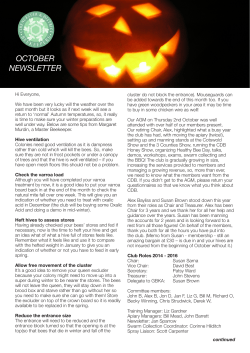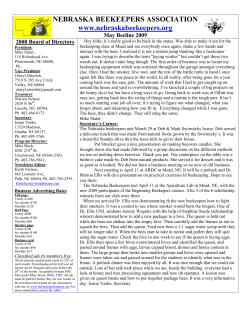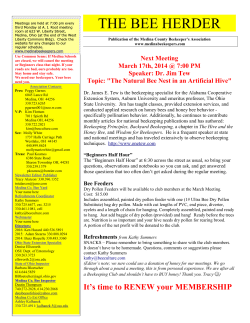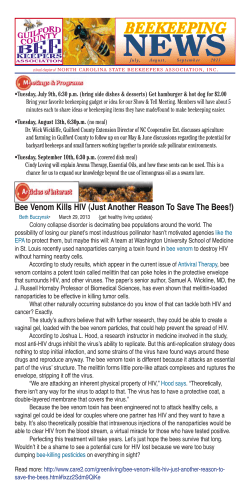
The occurrence of Melissococcus plutonius in healthy colonies of Apis... and the efficacy of European foulbrood control measures
Journal of Invertebrate Pathology 105 (2010) 164–170 Contents lists available at ScienceDirect Journal of Invertebrate Pathology journal homepage: www.elsevier.com/locate/jip The occurrence of Melissococcus plutonius in healthy colonies of Apis mellifera and the efficacy of European foulbrood control measures Giles E. Budge a,*, Ben Barrett a, Ben Jones a, Stéphane Pietravalle a, Gay Marris a, Panuwan Chantawannakul b, Richard Thwaites a, Jayne Hall a, Andrew G.S. Cuthbertson a, Mike A. Brown a a b The Food and Environment Research Agency, Sand Hutton, York, YO41 1LZ, UK Department of Biology, Faculty of Science, Chiang Mai University, Chiang, Mai 50200, Thailand a r t i c l e i n f o Article history: Received 11 March 2010 Accepted 15 June 2010 Available online 19 June 2010 Keywords: Honey bee Disease control qPCR Epidemiology Detection Oxytetracycline Treatment a b s t r a c t European foulbrood (EFB) persists in England and Wales despite current treatment methods, all of which include feeding honey bee colonies with the antibiotic oxytetracycline (OTC). A large-scale field experiment was conducted to monitor a husbandry-based method, using comb replacement (known as Shook swarm), as a drug free EFB control option. The understanding of EFB epidemiology is limited, with little information on the presence of Melissococcus plutonius in disease free colonies. Additional samples were collected from diseased and disease free apiaries to identify symptomless infection. EFB reoccurrence was not significantly different between OTC and husbandry methods and real-time PCR data demonstrated that fewer Shook swarm treated colonies contained M. plutonius carryover to the Spring following treatment. Asymptomatic colonies from diseased apiaries showed an increased risk of testing positive for M. plutonius compared to asymptomatic colonies from disease free apiaries. The probability of a sample being symptomatic increased when a greater quantity of M. plutonius was detected in adult bees and larvae. The possibility of treating EFB as an apiary disease rather than a colony disease and the implications of a control strategy without antibiotics are discussed. Crown Copyright Ó 2010 Published by Elsevier Inc. All rights reserved. 1. Introduction European foulbrood (EFB) is an economically important disease of honey bee (Apis mellifera L.) larvae caused by the anaerobic Gram-positive lanceolate bacterium Melissococcus plutonius (ex White 1912) (Aleksandrova, 1949; Bailey and Collins, 1982). EFB is well distributed across every continent that honey bees inhabit (Matheson, 1993). Infected larvae usually die rapidly when they are 3–5 days old and in severe cases entire colonies can be lost. There are several other bacteria associated with EFB including Achromobacter eurydice, Brevibacillus laterosporus, Enterococcus faecalis and Paenibacillus alvei, although their roles in disease development are unclear (Alippi, 1991). The epizootiology of EFB is not fully understood and the epidemiology of the disease has been described as enigmatic (Forsgren et al., 2005; Pinnock and Featherstone, 1984). M. plutonius is known to be present in larvae from healthy colonies (Pinnock and Featherstone, 1984; McKee et al., 2003; Forsgren et al., 2005) and Australian researchers have demonstrated that adult bees can carry the bacterium (McKee et al., 2003). * Corresponding author. Fax: +44 1904 462240. E-mail address: [email protected] (G.E. Budge). Colonies of the European or Western honey bee (A. mellifera L.) are kept in hives often made of wood, which typically contain between 10 and 24 frames housing wax foundation. These serve as templates that enable the bees to easily draw the comb within which they raise their young (known as brood). At the height of the summer a honey bee colony in a temperate climate contains 40,000–60,000 female worker bees (falling to 10,000–15,000 in the winter); several hundred male drones; and a single mated queen (Winston, 1991). To allow for efficient management, groups of bee colonies are kept in apiaries. In England and Wales, an average apiary will comprise four colonies, although this number can fluctuate from two (hobbyist beekeepers) to over 20 for commercial apiaries. In 2006, 556 colonies from 224 apiaries in England and Wales were confirmed as clinically infected with EFB. The vast majority of diseased colonies were situated in the South of England and Wales. No cases of EFB were discovered north of Ripon in North Yorkshire (www.nationalbeeunit.com). The bacteriostatic antibiotic oxytetracycline (OTC) has been used to treat EFB in England and Wales since 1967. However, treated apiaries have high (27%) reoccurrence rates of the disease (Thompson and Brown, 2001). ‘‘Shook swarm” with OTC has been reported as an effective alternative for the control of EFB, with lower levels of colony disease reoccurrence (5%) (Waite et al., 2003). This method involves a transfer of adult bees to a clean brood 0022-2011/$ - see front matter Crown Copyright Ó 2010 Published by Elsevier Inc. All rights reserved. doi:10.1016/j.jip.2010.06.004 165 G.E. Budge et al. / Journal of Invertebrate Pathology 105 (2010) 164–170 box containing new foundation, followed by supplemental feeding with OTC amended sugar solution (Waite et al., 2003). Whilst showing promising results, Shook swarm with OTC still involves the use of antibiotics, and therefore requires a withdrawal period of at least 16 weeks post-treatment to avoid excessive residues in honey (Thompson et al., 2006). Using a suitable withdrawal period, it is possible to apply OTC for the treatment of EFB within EU member states via the ‘‘cascade” system (EU Directive 2001/82/ EC). Whilst resistance to OTC has been reported for Paenibacillus larvae, the causative organism of American foulbrood (Kochansky et al., 2001), no such resistance has been reported in M. plutonius populations. The aim of this work was to assess the efficacy of OTC and Shook swarm without OTC for the control of EFB in England and Wales using a combination of symptom data from the field and real-time polymerase chain reaction (PCR) protocols for the accurate detection and quantification of M. plutonius. 2. Methods 2.1. Sample collection Samples of adult bees and larvae were collected in 2006 from apiaries with EFB throughout England and Wales. Apiaries were owned by local beekeepers and managed according to good husbandry practice. Colonies symptomatic for EFB were selected randomly for either Shook swarm (n = 26) or OTC (n = 32). Shook swarm treatment consisted of removal of adult bees to a clean hive containing new foundation, followed by feeding as required (without the addition of OTC). Colonies selected for Shook swarm contained adult bees covering at least 6 British standard brood frames (6 768 cm2); a laying queen; and had sufficient time in the year to quickly and completely draw-out the foundation and replace the lost brood. Treated hives were moved a short distance from their original location and the boxes, floor, feeder, queen excluder and crown board all scorched or replaced. Brood boxes contained either new or sterilised frames fitted with new foundation. Where possible the queen was isolated, and reintroduced after treatment. The queen excluder was placed between the floor and the bottom brood chamber to prevent the colony absconding (this was removed once the queen had established a brood nest). Five centre frames were removed from the clean brood chamber and the adult population from the infected brood frames carefully shaken inside. Shaken colonies were fed with sugar syrup using a rapid feeder until the majority of the comb was drawn. The combs removed from the infected hives were destroyed by burning. OTC treatment consisted of a single dose of antibiotic (1 g ai) in 250 ml sucrose solution (1 kg sucrose in 568 ml water) trickled onto cells of an empty hive-frame on the edge of the brood nest. Respective dates of treatment varied slightly between Shook swarm (09/06/2006–11/08/2006) and OTC (12/06/2006–21/09/ 2006). Samples were also collected from symptomless colonies on apiaries with EFB and these were termed ‘contact colonies’ (n = 54). Finally, samples were collected from symptomless colonies from apiaries that were free from EFB (n = 61). For each colony, samples of larvae and adult bees were collected at random from the brood area and placed in 35 ml CTAB buffer (120 mM sodium phosphate buffer pH 8, 2% CTAB, 1.5 M NaCl, 2% antifoam B emulsion). Sample were collected at four time-points: pre-treatment (A); 1–2 months post-treatment (B); end of the 2006 season (C; late August–September); and in Spring 2007, with an incomplete replication of colonies for each time-point. A DNA extract was prepared from each sample by grinding 100 individuals in a ‘long special universal’ bag using a Lenze grinder (Bioreba). DNA was extracted from cleared lysate using a WizardÒ Magnetic DNA Purification System for Food (Promega, FF3750) in conjunction with a Kingfisher ML magnetic particle processor (Thermo Electron Corporation) (Ward et al., 2007a). In addition, buffer controls were prepared in parallel during DNA extraction to monitor for extraction contamination. Each DNA extract was tested for the presence of M. plutonius 16S and A. mellifera 18S ribosomal rRNA using real-time PCR. 2.2. Real-time PCR testing Real-time primers and probe were designed using Primer Express software (Applied Biosystems, Branchburg, New Jersey, USA). EFB assay EFBFor/EFBRev2/EFBProbe was selected to amplify a specific fragment of the 16S rRNA from M. plutonius (Accession AJ301842). The closest sequence matches for each primer were determined by comparing all the published sequences on the NCBI database using the BLASTN search algorithm. Assay specificity was confirmed by testing against nucleic extracts from a panel of bacteria chosen because of their known association with honey bees or EFB (Table 1). Assay AJ307465-955F/1016R/975T (amplicon length 62 nt) was designed to A. mellifera 18S rRNA (Ward et al., 2007b), and used as an internal control to normalise for extraction efficiency. Both fluorogenic probes were modified 30 with TAMRA (tetra-methylcarboxyrhodamine) and 50 with FAM (6-carboxyfluorescein). Real-time reactions were set-up using TaqManÒ chemistry in 384 well reaction plates using PCR core-reagent kits (Applied Biosystems, Branchburg, New Jersey, USA), according to the manufacturer’s protocols. Each reaction comprised 1x buffer A, 0.025 U/ll AmpliTaq Gold, 0.2 mM each dNTP, 5.5 mM MgCl2, 300 nM each primer, 100 nM probe and 10 ll of nucleic acid extract in a final volume of 25 ll. Negative controls comprised of Table 1 Specificity testing of real-time assay EFBFor/EFBRev2/EFBProbe against DNA preparations from a panel of bacteria. Species Fera number LMG number Average Cq Paenibacillus larvae P. larvae P. larvae P. larvae P. larvae P. larvae P. larvae P. larvae P. larvae P. larvae P. larvae P. larvae P. larvaes Paenibacillus alvei P. alvei P. alvei P. alvei P. alvei P. macerans P. macquariensis P. polymyxa Achromobacter eurydice Brevibacillus laterosporus B. laterosporus Enterococcus faecalis Melissococcus plutonius, Type strain M. plutonius, UK M. plutonius, UK M. plutonius, Thailand M. plutonius, Thailand Water control Capped water control 6254 6255 6256 6257 6258 6259 6260 6261 6262 6263 6264 6265 6266 6558 6559 6560 6561 6562 6563 6564 6565 7100 6672 6673 6674 6679 9820 14,425 14,426 16,147 16,148 16,241 16,250 16,251 14,428 15,974 16,247 16,249 16,252 13,255 13,260 16,913 17,051 17,052 6324 6935 13,924 – 16,000 15,110 7937 20,360 40.00 40.00 40.00 40.00 40.00 40.00 40.00 40.00 40.00 40.00 40.00 40.00 40.00 40.00 40.00 40.00 40.00 40.00 40.00 40.00 40.00 40.00 40.00 40.00 40.00 27.78 7086 7087 7148 7149 – – – – – – – – 23.52 21.98 21.45 21.62 40.00 40.00 166 G.E. Budge et al. / Journal of Invertebrate Pathology 105 (2010) 164–170 nuclease-free water were included in every run. TaqManÒ PCR reactions were carried out in duplicate wells and plates cycled using generic system conditions (95 °C for 10 min and 40 cycles of 60 °C for 1 min plus 95 °C for 15 s) in a 7900 Sequence Detection System (Applied Biosystems, Branchburg, New Jersey, USA) with real-time data collection. 2.3. Quantification Quantification of M. plutonius in each sample was achieved using the method described by Garrido et al. (2008) with assay EFBFor/EFBRev2/EFBProbe (M. plutonius 16S) as the target and assay AJ307465-955F/1016R/975T (A. mellifera 18S) as the reference. For the target assay, a 1:10 dilution series was created by adding 10 to 1 108 of M. plutonius cells (Type strain LMG 20360), quantified by measuring absorbance at 450 nm, to crushed healthy A. mellifera. Similarly, a dilution series was prepared for the reference assay using A. mellifera DNA. To allow actual quantification, the number of copies of the haploid honey bee genome were estimated in the reference dilution assuming a genome size of 236 MB (Honeybee genome sequencing consortium, 2006). Replicate aliquots (n = 10) of the reference dilution were quantified using a Nanodrop spectrophotometer (Thermo Scientific) and the average number of copies of the haploid honey bee genome calculated. The actual amounts of M. plutonius and A. mellifera DNA were extrapolated from the respective standard curves (User Bulletin 2, Applied Biosystems). Quantification cycle (Cq; Bustin et al., 2009) was defined as midway through the exponential phase of the amplification curve equating to a DRn of 0.13 and 0.16 respectively for M. plutonius and A. mellifera assays. To account for variation in extraction efficiency between samples, the result was expressed as a ratio of the number of M. plutonius and A. mellifera cells. The standard errors (SE) of the normalised quantity were calculated using an approximation of the Taylor series (Gil-Salas et al., 2007). The final calculation for the actual quantification of each DNA extract was expressed as the number of cells of M. plutonius per haploid honey bee cell. 2.4. Statistical analyses Quantitative real-time PCR data were analysed using a linear model with log(number of cells of M. plutonius per haploid honey bee cell) as the response, and treatment and sample timing as the predictors. Qualitative data were analysed using logistic regression with real-time PCR result as the response variable (expressed as binary with Cq = 40 as the threshold) and treatment as the predictor. Reoccurrence and colony loss figures were collated from inspection data at the end of the 2007 inspection season and analysed using logistic regressions. Means were separated using least significant difference as appropriate. Quantitative predictions on the quantity of inoculum required for symptom expression at time-point A were estimated from a generalised linear model with the presence of symptoms as a response and the lognumber of cells of M. plutonius per haploid honey bee cell as the explanatory variable. All analyses were completed using Genstat version 12.1. rence was lower in Shook swarm treated colonies (0.04, approx. se = 0.04) compared to OTC treated colonies (0.22, approx. se = 0.07). Untreated colonies had an estimated reoccurrence probability of 0.08 (approx. se = 0.04). In 2007, no significant differences in colony mortality were recorded between Shook swarm treated (27%), OTC treated (25%) and untreated colonies (20%) (Chi-square = 0.51, d.f. = 2, p = 0.77). Due to the practice of beekeepers clearing away dead colonies, it was not possible to obtain samples from failed colonies. 3.2. Real-time PCR assay design and specificity testing Real-time PCR assay EFBFor (TGT TGT TAG AGA AGA ATA GGG GAA), EFBRev2 (CGT GGC TTT CTG GTT AGA) and EFBProbe (FAM AGA GTA ACT GTT TTC CTC GTG ACG GT - TAMRA) was designed to specifically detect M. plutonius 16S rRNA (amplicon length 69 nt). Results of the BLASTN searches revealed no exact nucleotide matches for either primer sequences other than four sequences of M. plutonius 16S rRNA (AJ301842, AY862507, X75751, X75752). Assay EFBF/EFBR/EFBProbe only reacted with DNA preparations of M. plutonius and showed no cross-reaction with a panel of other bacteria (Table 1). Buffer controls prepared in parallel during DNA extraction tested negative using the M. plutonius and A. mellifera real-time PCR assays, suggesting no contamination during DNA extraction. 3.3. Qualitative analysis There was a significant association between visual EFB symptoms and the real-time PCR result for samples collected pre-treatment (Larvae – Chi-square = 62.32, d.f. = 1, p < 0.001; Adult bees Chi-square = 86.07, d.f. = 1, p < 0.001). All larvae (58/58) and most adult bees (56/57) collected pre-treatment from colonies with EFB symptoms tested positive for M. plutonius using real-time PCR. Logistic regression analysis of samples of larvae and adult bees collected in Spring 2007 demonstrated a significantly higher proportion of OTC treated colonies tested positive for M. plutonius compared to those treated using Shook swarm (Larvae: Change of deviance = 7.92, d.f. = 1, p = 0.005; Adult bees: Change of deviance = 5.47, d.f. = 1, p = 0.02) (Fig. 1). Many symptomless colonies also tested positive for M. plutonius using real-time PCR, providing clear evidence of symptomless infection. A significantly higher proportion of larvae and adult bees from asymptomatic ‘contact colonies’ (Larvae 27/52; Adult bees 3. Results 3.1. Reoccurrence and colony mortality Logistic regression analysis of EFB reoccurrence data in 2007 suggested a borderline significance when Shook swarm treated, OTC treated and untreated colonies were compared (Change of deviance = 5.76, d.f. = 2, p = 0.056). The probability of EFB reoccur- Fig. 1. Estimated proportion of symptomatic samples that tested positive for M. plutonius in Spring 2007 using real-time PCR. Error bars represent standard error of the mean. G.E. Budge et al. / Journal of Invertebrate Pathology 105 (2010) 164–170 167 23/54) tested positive for M. plutonius compared to asymptomatic colonies sampled from EFB free apiaries (Larvae 15/61; Adult bees 3/61) (Larvae: Change of deviance = 9.06, d.f. = 1, p = 0.003; Adult bees: Change of deviance = 25.34, d.f. = 1, p < 0.001). 3.4. Quantitative analysis Standard curves prepared from serial dilutions of M. plutonius and honey bee DNA were suitable for quantification with respective R2 values above 0.99 (Fig. 2). Linear regression analysis of log quantitative data revealed significantly higher amounts of M. plutonius bacteria in larvae and adult bees from symptomatic colonies compared to asymptomatic colonies before treatment in 2006 (Fig. 3). ‘Contact colonies’ contained significantly more bacteria on adult bees compared to colonies sampled from EFB free apiaries (Fig. 3). Shook swarm and OTC treatments each reduced the levels of bacteria 1–2 months after treatment in both larvae and in adult bee samples (Fig. 3). However, larvae from OTC treated colonies contained significantly more bacteria than ‘contact colonies’ (Fig. 3). Shook swarm and OTC treatments each reduced the levels of M. plutonius bacteria in larvae and in adult bee samples collected in Spring 2007 to similar levels as colonies that had been asymptomatic in 2006 (Fig. 3). Fig. 3. Quantitative real-time PCR result for all samples of larvae and adult bees collected pre-treatment (A); 1–2 months post-treatment (B); end of the 2006 season (C); and in Spring 2007 (D). The log number of M. plutonius bacteria was normalised against the number of copies of the honey bee genome in each sample. Means represent predictions from a linear regression. Means were separated using approximate least significant differences after adjusting for multiple comparisons within sample timing. Significantly different means (95%) are represented by suffixes a–c. A significant increase in the probability of a sample being symptomatic was observed with increasing log-number of cells of M. plutonius per haploid honey bee cell at time-point A (Larvae: Change of deviance = 141, d.f. = 1, p < 0.001; Adult bees: Change of deviance = 135, d.f. = 1, p < 0.001) (Fig. 4). The log-number of cells of M. plutonius per haploid honey bee cell required to produce symptoms in 95% of samples, as estimated from the logistic regression, was higher in larvae (4.07; 95% C.I. 3.37, 5.16) than adult bees (3.02; 95% C.I. 2.58, 3.75). 4. Discussion Fig. 2. Dilution series (1:10) showing the linear relationship between log-concentration and real-time PCR quantification cycle for (A) the M. plutonius 16S rRNA target assay EFBFor/EFBRev2/EFBProbe and (B) the A. mellifera 18S reference assay AJ307465-955F/1016R/975T. The annual contribution of honey and other hive products to the UK economy is ca. £20M, but this figure is small compared to the value of the pollination services provided to crops by the bees themselves (ca. £165M) (Carreck and Williams, 1998; Cuthbertson and Brown, 2006, 2009). The contribution that bees make to the 168 G.E. Budge et al. / Journal of Invertebrate Pathology 105 (2010) 164–170 Fig. 4. Change in probability of disease expression with increasing amount of M. plutonius in samples of (A) larvae and (B) adult bees collected at time-point A (pretreatment). Plot represents the fitted logistic curve from the generalised linear model. global economy runs into hundreds of billions of dollars (Borneck and Merle, 1989; Corbet et al., 1991; Morse and Calderone, 2000; Gordon and Davis, 2003 Gallai et al., 2009). Under such circumstances, there is a clear need to maintain disease free honey bee stocks. The present study shows that Shook swarm appeared more successful than OTC for the control of EFB in England and Wales. In the Spring following treatment, shaken colonies were three times less likely to test positive for M. plutonius (Fig. 1). This finding appears logical since OTC treatment does not remove the etiological agent present in the hive. In contrast, the Shook swarm method provides the bees with M. plutonius-free material. In addition, OTC treated colonies were five times more likely to represent with EFB the following year than Shook swarm treated colonies. Data directly comparing Shook swarm and OTC treatments have not been presented previously. The use of OTC of the control of EFB is not permitted in many European countries, and when used requires a withdrawal period of at least 16 weeks post-treatment to avoid excessive residues in honey (Thompson et al., 2006). When honey flows coincide with withdrawal periods, this can lead to a large reduction in the production of marketable honey. The Shook swarm method presented here is as effective as the existing drug-based disease management options, but also has the advantage that no antibiotics are used, negating the risk of antibiotic contamination of honey after treatment. Beneficial Lactobacillus and Bifidobacterium have been shown to inhibit the growth and infection rate of Paenibacillus larvae in honey bee larvae (Forsgren et al., 2009). Antibiotic usage may have a negative effect on beneficial populations, increasing the likelihood of disease (re)occurrence once the antibiotic efficacy recedes. There are several hundred confirmed cases of EFB in England and Wales annually that require considerable resources to fund apiary inspections, diagnoses and management (Wilkins et al., 2007). EFB is endemic in Switzerland, and cases of the disease have increased 10-fold over the last 10 years (Roetschi et al., 2008). Sanitisation procedures in Switzerland were recently found to be inadequate for eliminating M. plutonious from EFB affected apiaries (Roetschi et al., 2008). Adopting a control method that reduces disease reoccurrence could considerably reduce the amount of resources used for treating EFB outbreaks in the UK. Moreover, such disease management techniques may also be applicable in other countries like Switzerland. Both applications would lead to healthier bee stocks, and thus help to protect the vital role of honey bees as crop pollinators. The presence of M. plutonius can be confirmed by microscopic examination of Nigrosin stained smears prepared directly from diseased brood (Alippi, 1991) and bacteria can be recovered using media amended with nalidixic acid (Hornitzky and Smith, 1998). However, M. plutonius is difficult to culture and establishing the bacterium in vitro can be difficult (Govan et al., 1998). Pinnock and Featherstone reported an enzyme-linked immunosorbent assay (ELISA) for the detection and quantification of M. plutonius (Pinnock and Featherstone, 1984). Such a method is useful for high throughput environmental studies, but it was unable to detect levels of M. plutonius less than 105 bacterial cells per ml. More sensitive methods have been reported, including conventional PCR (Govan et al., 1998) and hemi-nested PCR (Djordjevic et al., 1998). These provide lower detection levels than ELISA, and have been used to successfully study disease aetiology (Belloy et al., 2007; Forsgren et al., 2005), however they are strictly qualitative. Real-time PCR represents a recent advance in PCR methodology, offering several advantages over conventional PCR for studies on M. plutonius. These include using a closed-tube system that is less prone to post-PCR contamination; no requirement for post-PCR manipulations such as visualising products on a gel; and accurate quantification. Quantitative real-time PCR data has provided insight into EFB aetiology and has been used to investigate the efficacy of sanitation measures for controlling the disease (Roetschi et al., 2008). The current study also demonstrates the value of real-time PCR in understanding disease aetiology and improving disease control measures. Quantitative real-time PCR was used in this study to demonstrate that bacterial levels prior to treatment differed significantly between symptomatic and asymptomatic colonies (Fig. 3). Such data suggest that disease thresholds may occur with EFB infection, corroborating recent data from Switzerland (Roetschi et al., 2008). Our analyses explore this further by investigating a way to monitor EFB outbreaks in the absence of costly inspections by inspectors qualified to recognise disease. Our real-time PCR methods could be used to attribute a risk of EFB infection to samples collected by beekeepers, measured as probability of the sample showing EFB symptoms. Such data could provide a trigger for a later inspection of those apiaries most at risk from the disease. Further investigations are necessary to determine whether the amount of M. plutonius in adult bees from the brood nest or larvae is more reliable for use as a predictor of disease. Our quantitative and qualitative data clearly demonstrate that asymptomatic colonies from apiaries with EFB present an increased risk of carrying M. plutonius G.E. Budge et al. / Journal of Invertebrate Pathology 105 (2010) 164–170 compared to asymptomatic colonies on apiaries free from EFB, a finding consistent with an earlier report (Belloy et al., 2007). Although asymptomatic colonies showed double the probability of disease reoccurrence compared with shaken colonies, this difference did not reach statistical significance at the 5% level. Further work is required to investigate whether ‘contact colonies’ should be subjected to a treatment regime to further reduce disease reoccurrence. Historically, EFB prevalence is low in the North of England and Wales compared to the South. Two hypotheses would support such an observation. Firstly, the low prevalence in the North of England and Wales could be due to the absence of the causal agent of EFB, M. plutonius. Secondly, M. plutonius could be ubiquitous across England and Wales, but the environmental conditions in the North are not conducive for disease expression. Belloy et al. (2007) presented data demonstrating that M. plutonius was absent from two apiaries located in an area of Switzerland free from EFB, suggesting M. plutonius is not ubiquitous in Switzerland. In the current study, all 18 EFB free apiaries located in North England and North Wales, where EFB has not been reported, tested negative for M. plutonius. This provides some evidence that M. plutonius may not be ubiquitous in England and Wales. Shaking colonies is an old idea for disease control that was widely adopted prior to the advent of antibiotics (e.g. Howard, 1907). The Shook swarm treatment emulates the natural behaviour of the honey bee to move nest site when disease pressure is high, thereby reducing the build-up of disease agents. Comb replacement into a clean box presents a disease free environment, and forces a break in the brood cycle that also provides a break in the disease cycle. Shaking is known to work for other bacterial diseases such as American foulbrood, where reinfection rates of about 5% have been recorded (Shimanuki and Knox, 1997). Ensuring shaken colonies have access to ample nutrition by supplemental feeding, and proper treatment timings are both essential for colony survival. Guler (2008) reported that shaking colonies 45 days before the main nectar flow, with no supplementary feeding, reduced honey yield and led to high colony mortality. Such data demonstrate the importance of supplemental feeding and the need to apply comb replacement at a time of year when bees are able to draw comb and store sufficient honey for winter periods (Shimanuki and Knox, 1997). The data presented in this study provide useful information that allows the comparison of different control options for EFB and also inform about EFB epidemiology. Several secondary bacteria have been indicated in the EFB disease complex (Alippi, 1991; Forsgren, 2010). Australian researchers recently suggested that in vitro reared larvae only developed EFB symptoms when both M. plutonious and P. alvei were present (Hornitzky and Giersch, 2008). Real-time PCR could be used to quantify the role played by other bacteria, like P. alvei, and further develop our understanding of this damaging brood disease of the honey bee. Acknowledgments The work was funded by the Department of Environment, Food and Rural Affairs, UK (Project Number PH0502). The authors would also like to thank the ABIs who contributed to this study by collecting field samples. References Aleksandrova, L.V., 1949. Growing the causative organism of European foulbrood (B. pluton) in pure culture. In: Boleznipchel, Gosudarstvennue lzdatelístovo, Moscow. Alippi, A.M., 1991. A comparison of laboratory techniques for the detection of significant bacteria of the honey bee, Apis mellifera, in Argentina. J. Apicult. Res. 30, 75–80. 169 Bailey, L., Collins, M.D., 1982. Reclassification of Streptococcus pluton (White) in a new genus Melissococcus, as Melissococcus pluton Nom Rev – Comb Nov. J. Appl. Bacteriol. 53, 215–217. Belloy, L., Imdorf, A., Fries, I., Forsgren, E., Berthoud, H., Kuhn, R., Charriere, J.D., 2007. Spatial distribution of Melissococcus plutonius in adult honey bees collected from apiaries and colonies with and without symptoms of European foulbrood. Apidologie 38, 136–140. Borneck, R., Merle, B., 1989. Essai d’une évaluation de l’incidence économique de l’abeille domestique dans l’agriculture européenne. Apiacta 24, 33–38. Bustin, S.A., Benes, V., Garson, J.A., Hellemans, J., Huggett, J., Kubista, M., Mueller, R., Nolan, T., Pfaffl, M.W., Shipley, G.L., Vandesompele, J., Wittwer, C.T., 2009. The MIQE guidelines: minimum information for publication of quantitative realtime PCR experiments. Clin. Chem. 55, 611–622. Carreck, N., Williams, I., 1998. The economic value of bees in the UK. Bee World 79, 115–123. Corbet, S.A., Williams, I.H., Osborne, J.L., 1991. Bees and the pollination of crops and wild flowers in the European Community. Bee World 72, 47–59. Cuthbertson, A.G.S., Brown, M.A., 2006. Vital pollinators: honey bees in apple orchards. Biologist 53, 78–81. Cuthbertson, A.G.S., Brown, M.A., 2009. Issues affecting British Honey bee biodiversity and the need for conservation of this important ecological component. Int. J. Environ. Sci. Technol. 6, 695–699. Djordjevic, S.P., Noone, K., Smith, L., Hornitzky, M.A.Z., 1998. Development of a hemi-nested PCR assay for the specific detection of Melissococcus pluton. J. Apicult. Res. 37, 165–173. Forsgren, E., 2010. European foulbrood in honey bees. J. Invert. Pathol. 103 (Suppl. 1), S5–S9. Forsgren, E., Lundhagen, A.C., Imdorf, A., Fries, I., 2005. Distribution of Melissococcus plutonius in honeybee colonies with and without symptoms of European foulbrood. Microb. Ecol. 50, 369–374. Forsgren, E., Olofsson, T.C., Vásquez, A., Fries, I., 2009. Novel lactic acid bacteria inhibiting Paenibacillus larvae in honey bee larvae. Apidologie 41, 99–108. Gallai, N., Salles, J.M., Settele, J., Vaissière, B.E., 2009. Economic valuation of the vulnerability of world agriculture confronted with pollinator decline. Ecol. Econom. 68, 810–821. Garrido, C., Carbú, M., Fernández-Acero, J.F., Boonham, N., Colyer, A., Cantoral, J.M., Budge, G., 2008. Development of protocols for detection of Colletotrichum acutatum and monitoring of strawberry anthracnose using real-time PCR. Plant Pathol. 58, 43–51. Gil-Salas, F.M., Morris, J., Colyer, A., Colyer, A., Budge, G., Boonham, N., Cuadrado, I.M., Janssen, D., 2007. Development of real-time RT-PCR assays for the detection of Cucumber vein yellowing virus (CVYV) and Cucurbit yellow stunting disorder virus (CYSDV) in the whitefly vector Bemisia tabaci. J. Virol. Methods 146, 45–51. Gordon J., Davis L. (2003). Valuing Honeybee Pollination. Rural Industries Research and Development Corporation Australia RIRDC Report 03/077. Govan, V.A., Brozel, V., Allsopp, M.H., Davison, S., 1998. A PCR detection method for rapid identification of Melissococcus pluton in honeybee larvae. Appl. Environ. Microb. 64, 1983–1985. Guler, A., 2008. The effects of the shook swarm technique on honey bee (Apis mellifera L.) colony productivity and honey quality. J. Apicult. Res. 47, 27–34. Hornitzky M., Giersch T. (2008). Fatty Acids do not Protect Larvae from Developing European Foulbrood. OIE Symposium – Diagnosis and Control of Bee Diseases, Freiburg, Germany. Hornitzky, M.A.Z., Smith, L., 1998. Procedures for the culture of Melissococcus pluton from diseased brood and bulk honey samples. J. Apicult. Res. 37, 293–294. Howard L.O., 1907. Report of the Meeting of Inspectors of Apiaries San Antonio, Texas, November 12, 1906. USDA Bur. Entomol. Bull. 61. Kochansky, J., Knox, D.A., Feldlaufer, M., Pettis, J.S., 2001. Screening alternative antibiotics against oxytetracycline-susceptible and -resistant Paenibacillus larvae. Apidologie 32, 215–222. Matheson, A., 1993. World bee health report. Bee World 74, 176–212. McKee, B.A., Djordjevic, S.P., Goodman, R.D., Hornitzky, M.A., 2003. The detection of Melissococcus pluton in honey bees (Apis mellifera) and their products using a hemi-nested PCR. Apidologie 34, 19–27. Morse, R.A., Calderone, N.W., 2000. The value of honey bee pollination the United States. Bee Cult. 128 (Suppl.), 1–15. Pinnock, D.E., Featherstone, N.E., 1984. Detection and quantification of Melissococcus pluton infection in honeybee colonies by means of enzyme linked immunosorbent assay. J. Apicult. Res. 23, 168–170. Roetschi, A., Berthoud, H., Kuhn, R., Imdorf, A., 2008. Infection rate based on quantitative real-time PCR of Melissococcus plutonius the causal agent of European foulbrood in honeybee colonies before and after apiary sanitation. Apidologie 39, 362–371. Shimanuki, H., Knox, D.A., 1997. Summary of control methods. In: Morse, R.A., Flottum, K. (Eds.), Honey Bee Pests Predators and Diseases. A.I. Root Company, Medina, Ohio, pp. 493–514. Thompson, H., Brown, M.A., 2001. Is contact colony treatment with antibiotics an effective control for European foulbrood? Bee World 82, 130–138. Thompson, H.M., Waite, R.J., Wilkins, S., Brown, M.A., Bigwood, T., Shaw, M., Ridgway, C., Sharman, M., 2006. Effects of shook swarm and supplementary feeding on oxytetracycline levels in honey extracted from treated colonies. Apidologie 37, 51–57. Waite, R.J., Brown, M.A., Thompson, H.M., Bew, M.H., 2003. Controlling European foulbrood with the shook swarm method and oxytetracycline in the UK. Apidologie 34, 569–575. 170 G.E. Budge et al. / Journal of Invertebrate Pathology 105 (2010) 164–170 Ward, L., Brown, M.A., Neumann, P., Wilkins, S., Pettis, J., Boonham, N., 2007a. A DNA method for screening hive debris for the presence of small hive beetle (Aethina tumida). Apidologie 38, 272–280. Ward, L., Waite, R., Boonham, N., Fisher, T., Pescod, K., Thompson, H., Chantawannakul, P., Brown, M.A., 2007b. First detection of Kashmir bee virus in the UK using real-time PCR. Apidologie 38, 181–190. Wilkins, S., Brown, M.A., Cuthbertson, A.G.S., 2007. Perspective: the incidence of honey bee pests and diseases in England and Wales. Pest Manage. Sci. 63, 1062– 1068. Winston, M.L., 1991. The Biology of the Honey Bee. Harvard University Press, Cambridge, MA.
© Copyright 2025









